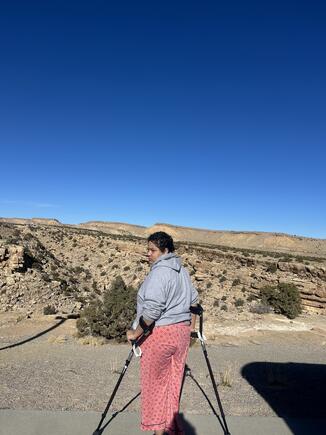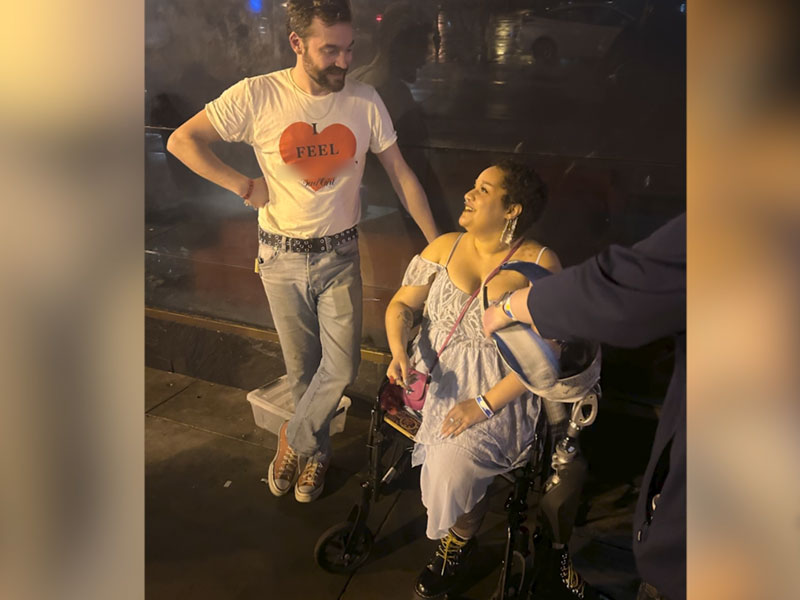The 19-year-old has cancer and savors her days with an optimism that is downright inspiring. Her home hospice nurse brings decades of caring and expertise to what has become a genuine friendship.
The palliative care doctor, who first met the 19-year-old when she was in elementary school, sees rare toughness from one and rare commitment from the other.
Cheyenne Sanger of Sioux Falls, South Dakota, is the 19-year-old who has been dealing with cancer since she was a child. Becky Jibben is the Sanford Health RN case manager who helps Sanger navigate the challenges of dealing with serious illness.
Sanford Health’s Daniel Mark, M.D., is the pediatric palliative care doctor who helps families and their children with difficult medical circumstances.
Together, they’re a team of sorts, with the goal to make days as good as they can be for Sanger, who shoulders her difficult prognosis with a spirit that combines grace and grit.
“I’ve always known that one day the cancer would take me out,” said Sanger, a Lincoln High School graduate who counts knitting, singing and playing the guitar as favorite hobbies. “It’s not that big of a deal to me to adjust. I mostly keep my eyes on the next big thing that I’m going to do instead of thinking about ‘Oh my God, I’m dying.’”
Half-joking request
Which brings us to a recent “next big thing” that Sanford Hospice made possible for Sanger.
Sanger is a huge fan of SadGirl, a Los Angeles-based band that has played all over the United States at one time or another but does a great percentage of its performing on the West Coast.
Seeing them play live would involve significant obstacles for Sanger and her family, but so does a lot of life they deal with on a daily basis. In this case, there was no reason to be in a hurry to set up preemptive roadblocks for a SadGirl concert.
“I talked to my parents, and I didn’t expect them to say yes. I was kind of bringing it up to them sort of jokingly,” Sanger said. “And they were like, ‘Well, OK, let’s do it.’ I was shocked by that.”
Difficult diagnosis
In 2017, sixth-grader Sanger was diagnosed with osteosarcoma, a type of bone cancer. Over the next five years, doctors performed several surgeries to save her leg but by 2023 amputation was necessary.
The amputation did not stop the cancer, which has since then advanced to her lungs and required additional procedures. She now has stage 4 metastatic osteosarcoma that is no longer responding to treatment.
“She has gone through every single medical option that could potentially cure her,” Dr. Mark said. “She recognizes that. At the same time, there is always some kind of hope. She is holding a hope of something happening in the future, some sort of therapy, while also holding out the hope that the remaining time that she has can be as enjoyable and comfortable and happy as possible.”
Sometime after Sanger’s parents, Ben and Christine, gave the journey the green light — but before the RV was loaded up and ready to roll westward, she had another setback. This warranted home hospice care and threw into jeopardy what for Sanger represented the world’s coolest road trip.
Making it happen
This is where Jibben, Sanger’s hospice case manager with more than 37 years of nursing experience, comes in. She wanted to make it happen.
To that end, Jibben asked Sanger’s father for an itinerary of their trip, then began contacting hospice care providers along the route. There would be overnight stops in Salina, Kansas, and Grand Junction, Colorado, on the way to Las Vegas, then Los Angeles. Then there would be return visits to Las Vegas, Grand Junction and Salina.
In all, Jibben set up seven different hospice agency contracts that would ensure Sanger received care if needed. In a sense, it was a relay race with seven runners. The Sangers’ RV was the baton.
“If Cheyenne was having symptoms, her first call would be to me and I would try to help over the phone. But if she would need to have someone come and visit her, we would have somebody available to go out and see her,” Jibben said. “We want our patients to be able to go out like Cheyenne and be able to fulfill their bucket list and do these types of things.”

Photo by Simon Floss, Sanford Health
Which brings us to the trip itself and Sanger’s visit to the Glass House, a well-known concert hall in Pomona, California.
Sanger’s grandmother, Margo, sent a message to lead singer Misha Lindes via Facebook and told them Sanger would be at the show. She also filled them in on her granddaughter’s daunting circumstances.
“I didn’t tell my grandmother to do this,” Sanger said. “If she would have asked, I would have told her not to. She basically told him ‘My granddaughter is a huge fan of you guys and she is coming all the way from South Dakota to see you at the Valentine’s show.’ And she probably pulled the ‘she’s dying’ card on them.”
Lindes responded and prior to the show they got a chance to meet. They talked about the TV show “Parks and Recreation” and snails, which are Lindes’ favorite animal. Like the RV they arrived in, it was all over the map.
“I was in the handicapped section next to the stage and Misha was everywhere running around before and during the concert,” Sanger said. “He came and talked to me a few times and he gave me a gift bag full of stuff. He was just so sweet.”
‘So that was good’
Sanger did not need hospice nurse attention along the route, but she would not have been able to leave on such an extended trip without Jibben setting up a network. Jibben and her colleagues involved in Sanford home hospice care will often see a patient’s challenge and problem-solve their way to making a dream a reality.
As it was for Cheyenne and so many others, “Why not?” was the starting point.
“This was such an exciting time to be able to see her go and to be able to do all these things and to be able to go with her family,” Jibben said. “We want people on hospice to go and enjoy life. We make sure that they have enough medications to take on their trips. … Whether it’s days, months or years that they’re on hospice, we want them to get out and enjoy these things.”
Jibben knows her patient well. They joke in ways that friends joke, with Jibben ribbing Sanger about being high-maintenance – “Most of my patients want a trip to the Black Hills. Cheyenne decides she is going to California.” For the camera at the request of a previous interviewer, Sanger replied with her own irritations.
“But then she said she loved me,” said Jibben, who had been at her side during the interview. “So that was good.”
Longtime toughness

Photo courtesy of Cheyenne Sanger
Sanger’s medical journey has included incremental amputations of her leg. Dr. Mark has overseen pain management for these procedures and has worked closely with Sanger’s family, as well as the team of specialists, physical therapists and hospice providers who have cared for her.
It is part of Dr. Mark’s job to help Sanger stay comfortable. This demands a lot of questions and answers centered on “How are you feeling?” It can be a good way to get to know someone and see what they’re all about.
“She is an incredibly tough person in the way she was going to handle whatever was thrown at her,” Dr. Mark said. “So from a pain management standpoint, I wasn’t actually really needed when I first met her because she was going to tolerate a lot. She was going to endure a lot.”
That trait persists, both in the manner she handles physical pain and the way she has dealt with her own situation. Dr. Mark has been part of conversations with Sanger that involve life’s ultimate boundaries.
“Even when things have come about where it has been time to discuss some really serious and difficult news, she hasn’t shied away from that,” Dr. Mark said. “She has been a part of it fully invested in the conversation. That’s a rare quality to see in someone who is faced with some of the most difficult news that a person can be faced with.”
A valued companion
Sanford hospice care has become a partner in Sanger’s journey. That includes a whole lot of tough stuff, but now also a road trip to California with her parents and her twin brother Dakota. They made it through a snowy stretch in the mountains to see SadGirl and have a conversation with Misha Lindes.
“I’m so thankful,” Sanger said. “Oh my gosh, I love concerts, and I thought I would never get to see SadGirl ever because they’re not coming all the way out here. But I did get to see them and that was crazy. I’m still so happy.”
It can be difficult to define hospice care. Sometimes, as in Sanger’s case, you can get a better handle on it when you see it in action. As Dr. Mark describes it, Sanger’s attitude is a combination of realism – recognizing what likely lay head – and hopes that may seem less possible.
“The role of our hospice team is to give her a chance to keep those hopes and help her attain them,” he said. “I used to think I knew what the phrase ‘indomitable spirit’ meant, but then I met Cheyenne. Now I know. What you see when you know her – that’s an indomitable spirit.”
Learn more
- Hospice providers make patients feel like family
- Mom grateful for daughter’s in-home hospice care
- Farmer in hospice takes one last trip to the farm
…
Posted In Cancer, Children's, Hospice, Nursing and Nursing Support

